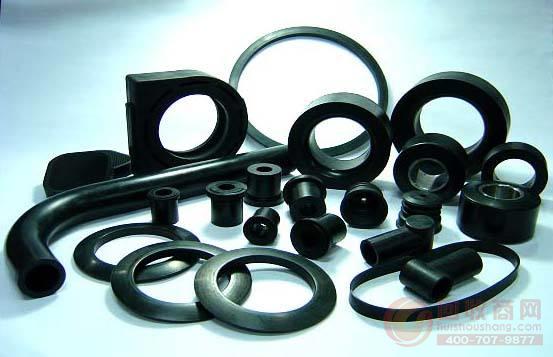
Universal rubber sealing material
General-purpose rubber sealing products have become more and more widely used in defense, chemical, coal, petroleum, metallurgy, transportation and machinery manufacturing industries, and have become the basic parts and accessories in various industries.
Common materials for rubber sealing products are as follows.
1 nitrile rubber
Nitrile rubber has excellent resistance to fuel oil and aromatic solvents, but it is not resistant to ketones, esters and hydrogen chloride. Therefore, it is mainly resistant to oil-sealed products and nitrile rubber.
2 neoprene
Neoprene has good oil and solvent resistance. It has good resistance to gear oil and transformer oil, but it is not resistant to aromatic oils. Neoprene also has excellent weathering and ozone aging properties. The cross-linking breaking temperature of the neoprene rubber is above 200 ° C, and the door and window sealing strip is usually made of neoprene. Neoprene also has good corrosion resistance to inorganic acids. In addition, since the neoprene rubber also has good flexibility and gas impermeability, it can be formed into a sealing article for a diaphragm and a vacuum.
3 natural rubber
Compared with most synthetic rubbers, natural rubber has good comprehensive mechanical properties, cold resistance, high resilience and wear resistance. Natural rubber is not resistant to mineral oil, but is more stable in vegetable oils and alcohols. In the hydraulic brake system of the brake fluid composed of the mixed liquid of n-butanol and refined castor oil, the rubber ring is made of natural rubber, and the general sealant is also made of natural rubber.
4 fluoro rubber
Fluororubber has outstanding heat resistance (200 ~ 250 ° C), oil resistance, can be used to manufacture cylinder liner seals, plastic bowls and rotating lip seals, which can significantly improve the use time.
5 silicone rubber
Silicone rubber has outstanding resistance to high and low temperature, ozone and weathering resistance. It can maintain its unique flexibility, ozone resistance and weather resistance in the working temperature range of -70 to 260 °C. It is suitable for the production of thermal institutions. Required gaskets, such as strong light source lamp cover gasket, valve gasket and so on. Since silicone rubber is not resistant to oil, has low mechanical strength and is expensive, it is not suitable to produce oil-resistant sealing products.
6 EPDM rubber
The main chain of EPDM rubber is a fully saturated linear structure containing no double bonds, and its side chain has a diene ruthenium, which can be vulcanized by sulfur. EPDM rubber has excellent aging resistance, ozone resistance, weather resistance, heat resistance (long-term use in 120 ° C environment), chemical resistance (such as alcohol, acid, alkali, oxidant), but not Resistant to aliphatic and aromatic solvents. EPDM rubber has the lowest density in rubber with high filling characteristics, but lacks self-adhesiveness and mutual adhesion. In addition, EPDM rubber has outstanding steam resistance and can be used to make sealing products such as steam-resistant membranes. EPDM rubber has been widely used in washing machines, accessories and door and window sealing products in TV sets, or in the production of various composite profiles.
7 polyurethane rubber
Polyurethane rubber has excellent grindability and good gas impermeability, and its use temperature range is generally -20 to 80 °C. In addition, it has medium oil resistance, oxygen resistance and ozone aging resistance, but it is not resistant to acids, alkalis, water, steam and ketones. Suitable for the manufacture of various rubber sealing products such as oil seals, O-rings and diaphragms.
8-chloroether rubber
Chloroether rubber has the advantages of nitrile rubber, neoprene rubber and acrylate rubber. It has good oil resistance, heat resistance, ozone resistance, flame resistance, alkali resistance, water resistance and organic solvent resistance, and has good process performance. Its cold resistance is poor. In the case of less used temperatures, chloroether rubber is still a good material for the manufacture of oil seals, seals, gaskets, diaphragms and dust covers.
9 acrylate rubber
Acrylate rubber has heat-resistant oil (mineral oil, lubricating oil and fuel oil), especially oil resistance stability at high temperatures, generally up to 175 ° C, gap use or short-term temperature can be 200 ° C. Its disadvantage is poor cold resistance. Therefore, it is suitable for making oil seals of high temperature resistant oil in non-cold areas, but it is not suitable for sealing products which are subjected to tensile or compressive stress at high temperatures.
Hydrofluoroether as a third generation CFC alternative,the ODP is zero, GWP is low, and the atmospheric residence time is short, with low toxicity, no corrosion, no combustion, no smoke generation, good material compatibility, etc.It is widely used in many fields such as medical, electronics, metal, precision instruments, optical lenses, communications and aerospace. As a solvent, hydrofluoroether has low viscosity and surface tension, is easy to spread and wet uniformly, and is easy to dry quickly, non-combustible, and has good material compatibility. Excellent for screen coating thinners.
Cleaning Solution For Screen Lens
Cleaning Detergents,Eco Friendly Cleaning Solutions,Detergent For Screen Lens,Cleaning Solution For Screen Lens
Guangdong Giant Fluorine Energy Saving Technology Co.,Ltd , https://www.tuwtech.com